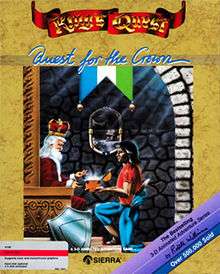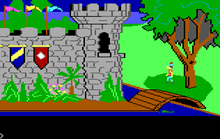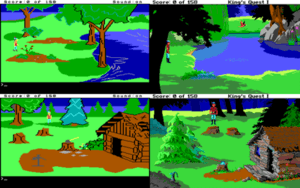King's Quest I
King's Quest is an adventure game developed by Sierra On-Line and published originally for the IBM PCjr in 1984 and later for several other systems between 1984 and 1989. The game was originally titled simply as King's Quest; the subtitle Quest for the Crown was added to the game box in the 1987 re-release, but did not appear in the game itself.
| King's Quest | |
|---|---|
 1987 re-release cover art | |
| Developer(s) | Sierra On-Line |
| Publisher(s) | IBM, Sierra On-Line |
| Designer(s) | Roberta Williams |
| Programmer(s) | Charles Tingley Ken MacNeill |
| Artist(s) | Doug MacNeill Greg Rowland |
| Writer(s) | Roberta Williams |
| Series | King's Quest |
| Engine | Adventure Game Interpreter (original) Sierra's Creative Interpreter (remake) |
| Platform(s) | IBM PCjr, Tandy 1000, Apple IIe, Apple IIGS, Atari ST, Amiga, Macintosh, MS-DOS, Master System |
| Release | May 10, 1984[1] July 1989 (SMS)[2] September 19, 1990 (remake) |
| Genre(s) | Adventure |
| Mode(s) | Single-player |
It is the first official part of the long King's Quest series (not counting 1980's Wizard and the Princess), in which a young knight, Sir Graham, must save the Kingdom of Daventry to become the king. Designed by Roberta Williams, the game was revolutionary and highly influential in the evolution of the graphic adventure game genre by introducing more detailed graphics and animation.
An official remake titled Roberta Williams' King's Quest I: Quest for the Crown was released in 1990. An unofficial remake was released by Tierra Entertainment in 2001.
Gameplay

King's Quest features interactive graphics that were an enormous leap over the mostly static 'rooms' of previous graphical interactive fiction. Prior to King's Quest, the typical adventure game presented the player a pre-drawn scene, accompanied by a text description. The player's interaction with the game consisted entirely of typing commands into the game's parser, then reading the parser's response, as the on-screen graphics rarely changed (except when the player moved to a new location).
King's Quest is the first adventure game to integrate graphical animation into the player's view of game world.[3] Because of this, King's Quest shifts the focus away from the static scenery, to the player's character, which is animated on-screen. There are animation sequences for most player-world interactions reachable through the normal course of exploration. For example, there are animation sequences showing Graham picking up objects from the ground, opening doors, and wading through water. Depth perspective is simulated as well; Graham can walk behind objects, causing his character to be hidden from view, or walk in front of them, obscuring the object. This attention to graphical animation, while commonplace in action games, earned King's Quest the distinction as the first "3D-animated" adventure game.
The original version of the game relies primarily on textual input as its interface. As the player uses the keyboard to explore the game world, the on-screen character, Graham, is animated walking to the chosen destination. The fantasy world of Daventry consists of an 8×6 cyclic array of screens (or rooms) that make up the outdoor world in which the player can navigate freely (except for the screen South of the East end of the castle, which must be reached by special means), plus 30 or so additional screens for indoor and underground places (including a smaller world in the clouds).
King's Quest was innovative in its use of 16-color graphics for the IBM PC platform. The game used the PCjr and Tandy 1000's Video Gate Array and enhanced sound, and those with the Color Graphics Adapter (CGA) computers could display 16-color graphics with artifact colors on a composite color monitor or television. Selecting 'RGB mode' at the title screen would instead result in the usual 320×200 CGA graphics mode limited to 4 colors. In this mode, dithering was employed to simulate extra colors. Like previous static-screen Sierra adventures, King's Quest used vector graphics rather than pre-rendered bitmaps which would take far too much disk space. Each screen is drawn line-by-line and painted in. This technique was used on all Sierra adventure games up to King's Quest V.
Plot
King's Quest
In the original version for the IBM PCjr, the story was simple. The Kingdom of Daventry is suffering from recent disasters and hardship. King Edward calls his bravest knight, Sir Grahame, to his throne, and tells him he has heard of three legendary treasures hidden throughout the land that would end Daventry's troubles. If Grahame succeeds he will become king.[4] In later releases, the knight's name was changed to Graham.
King's Quest: Quest for the Crown
Since the game's fourth release (1984) and the repackaged fifth release (1987), the backstory was greatly expanded. The Kingdom of Daventry is in serious trouble, after its precious magical items have been stolen. One day, King Edward the Benevolent rescued a beautiful young Princess Dahlia of Cumberland, but on the night of their wedding she was discovered to be really an evil witch who stole the king's treasure. Knowing that he had to save the kingdom, the dying King Edward sends his bravest knight, Sir Graham, to Cumberland on the quest to rid of the treacherous witch, outwit the other assorted villains, and retrieve the three lost treasures. Because he had no heir, if Graham should succeed, he would become the next king.[5]
Sir Graham embarked upon a quest for the items through Daventry, climbing a magic beanstalk to the Land of the Clouds where he recovered the chest of gold, facing leprechauns to retrieve the shield and a dragon to get back the mirror. After retrieving all of the items, Graham returned to the throne room in time to present them to the king before he died. As the king died, he passed on rule of Daventry to Sir Graham as promised.
Development
In late 1982, IBM contacted Sierra On-Line for launch titles for its forthcoming PCjr home computer, announced in November 1983.[6] Among the software Sierra developed was King's Quest, the first animated adventure game.[6][7] To create the interactive animation, the King's Quest development process deployed a prototype version of what would eventually become the Adventure Game Interpreter (AGI) game engine. This prototype engine was developed by Arthur Abraham, who was let go from the King's Quest project in the middle of development. In some early reporting on the game, the development system was referred to as the "Game Adaptation Language" (GAL).[8] In addition to the designer and writer Roberta Williams, six full-time programmers worked for 18 months to complete the game.
IBM, which paid for much of the $850,000 development cost, requested a sophisticated and replayable adventure game.[7] IBM stated in advertisements that King's Quest "runs on the IBM PCjr and makes good use of some special PCjr capabilities", with "unusually smooth and realistic" animation and "an impressive variety of sound effects".[9] Its discontinuation of the computer in March 1985 stunned Sierra.[10] Due to the PCjr's poor reception, King's Quest did not sell very well. With the advantage of the development system, Sierra was able to quickly release versions for the Tandy 1000, standard PCs, and the Apple IIe, which helped propel sales.[7]
Self-booting IBM PC compatible versions, requiring 128 KB of memory:
| Platform | Date | Notes |
|---|---|---|
| IBM PCjr | May 10, 1984[1] | Published by IBM in hard plastic case. Includes full keyboard overlay template. Not compatible with Tandy 1000 machines with more than 128 KB of memory. |
| late 1984 | Published by IBM in hard plastic case. The keyboard overlay template is replaced with a small strip for use with the non-chiclet replacement keyboard. Not compatible with Tandy 1000 machines with more than 128 KB of memory. | |
| IBM PC (CGA) | May 31, 1984[11] | Published by Sierra in gray cardboard box. Manual expands the backstory. |
| August 16, 1984[11] | Published by Sierra in gray cardboard box. Bug-fixed version, adds RGBI color mode. | |
| IBM PCjr / Tandy 1000 | May 25, 1985[11] | Published by Tandy Corporation in gray clamshell plastic box. States "Licensed to Tandy Corp." at the Sierra logo screen. |
| September 4, 1985[11] | Published by Sierra. Included as a second disk in package with the August 1984 PC CGA version. |

The game was re-released for DOS in 1986 using Sierra's updated AGI version 2 engine. It was also ported to the Amiga and Atari ST at the same time, and eventually to the Sega Master System. This 256K DOS version of King's Quest lacks some sound effects present in the booter versions, including birds chirping and distinct sounds for each enemy. It also adds some musical cues from King's Quest II, including "Greensleeves" replacing the original simple fanfare at the title screen. Background pictures are now drawn into an off-screen buffer to avoid the painting effect of the original game. This was not done merely for the sake of tidiness, but because the booter versions inadvertently gave away some puzzle solutions by drawing hidden objects first, followed by scenery.
IBM PC compatible versions running under DOS, requiring 256K memory. All versions published by Sierra.
- November 13, 1986,[12] Version 1.0U: Updated version, says "New version" on the title screen. Displays text in windows. Supports EGA graphics and runs from hard disks as well, although a key disk is required upon startup. Requires DOS 2.0, IBM PC with CGA graphics or PCjr/Tandy 1000. Unique in showing a discolored leaf at the title screen. Sold in the same gray flip-lid box as the 128K self-booting versions, with a grey triangular sticker denoting the 256K version, and a gold sticker stating "Now supports EGA".
- May 5, 1987,[12] Version 2.0F, interpreter version 2.425: Adds pull-down menus. Supports Hercules graphics and modifies the EGA graphics code to run on machines with an 80386 processor. Sold both in the original gray flip-lid box as well as a gold slipcover box. The gold slipcover box adds the sub-title "Quest for the Crown" for the first time, even as it is not mentioned in the game itself. First version of the game that was also available on 3.5" 720K disks.
- December 1, 1987,[11] Version 2.0F, interpreter version 2.917: Adds support for MCGA graphics.[13]
All floppy-disk based releases of the 128K and 256K versions use different forms of on-disk copy protection.
Other versions:
- 1984, Apple IIe & IIc: A version for Apple, based on the self-booting PC/Tandy 1000 version. Requires the 128k IIe or IIc to run.
- 1986, Amiga/Atari ST: Ports for 68000-based machines based on the 256K PC version 1.0U.
- 1988,[14] Apple IIGS: Based on the 256K PC versions, adds PCM sound effects and new music composed by Al Lowe.
King's Quest was not ported to the Commodore 64, despite its being the most important computer-game platform.[7] Roberta Williams said that the limitations of its graphic system (three colors per 8x8 block) did not permit Sierra to get the level of graphics detail they wanted. In addition, the computer's 64k of memory was too small to fit the complex AGI engine into. She said that she would always wanted to make an adventure game with animation, but it was not possible up to that point.
Sega Master System
The 1989 Master System port uses its own engine, with a verb/noun interface similar to early LucasArts titles. It has original tile and sprite-based graphics and was published by Parker Brothers, who in turn outsourced development to micro smiths, as they had done for a port of their own Montezuma's revenge. The game is based on the original King's Quest, and shares the puzzles and points-list of that game. Some of the puzzles and rooms have been modified a bit (for example, the boulder covering the dagger rolls a different direction than in PC). An extra item exists — it is now possible to pick up the three-leaf clovers. There are some extra places to die (including a dangerous staircase added to exit of the Leprechauns' realm). It is non-linear, and the three treasures can be collected in any order, like in the original PC version. Game saves were done through passwords.
1990 remake
King's Quest I: Quest for the Crown is a 1990 remake of King's Quest. This release is the "Enhanced" version of King's Quest. It uses the Sierra's Creative Interpreter (SCI) engine, the same engine used in titles such as King's Quest IV; while it still used 16-color graphics, it featured twice the resolution as well as music card support instead of the PC speaker. There are two different box variations for this release: one that used the same gold slipcover box as the 1987 256K version 2.0F and a box created specifically for the remake.
The game is not a 1:1 remake. The story was expanded upon (mainly in the cutscenes and conversations) and made more linear. There is a set order to finding the three treasures. The first two can be done in any order, but the last treasure is always the shield. Many of the character roles were expanded slightly to include more dialogue, and more characters were added. Some of the puzzle solutions were altered and some removed. The changes lead to the distribution of points being different in both games (though both add up to a total of 158). Some item locations were changed; the pebbles for example are found near the river in the original, but near a lake in their remake. Some locations were completely revamped (the stairs in the mountain were replaced with catwalks). The soundtrack was also expanded and included better musical cues when different characters appeared or action ensued.
The 1990 SCI EGA "Enhanced" version of King's Quest: Quest for the Crown was announced for the Atari ST line of computers and later canceled.[15] It is not known if a beta version exists or how far into development the game was, although it was announced via Sierra News Magazine in spring 1991. The magazine said owners could send disk #1 or the front cover of the manual along with a check or money order for $20 to upgrade their copy to the enhanced version.
Collections
Both versions of King's Quest I have been released in assorted collections beginning with the King's Quest 15th Anniversary Collector's Edition (1994), followed by the King's Quest Collection (1995), the King's Quest Collection Series (1996) and Roberta Williams Anthology (1997). The 2006 collection lacked the original AGI version of King's Quest, and contained only the SCI remake. This version was released on Steam in 2009. The original AGI version appears in the KQ1+2+3 collection released on GOG, but the SCI remake is not included.
Fan remake
In 2001, the group AGD Interactive (then known as Tierra Entertainment) released an unofficial remake based on Sierra's 1990 version, updating the graphics to use VGA colors, dropping the parser in favor of an interface that mimics that of King's Quest V, and full speech - including the voice of the original voice actor for King Graham in Sierra's official CD-ROM full-speech versions of King's Quest V and VI, Josh Mandel.[16] This was later updated with original hand-drawn artwork.
Reception
The Master System version of the game was given an average score of 6 out of 10 by reviewers in Electronic Gaming Monthly who highlighted its difficulty and its lack of appeal to a number of Sega fans.[17]
The 1990 enhanced version was described by critics and fans alike at the time as 'destroying a classic', and was compared to the controversial practice of colorizing classic black and white movies.[18] The remake was a critical failure and prevented the release of further remakes in the series.
References
- USCO registration number TX0001393675. The 1994 King's Quest Collection implausibly claims a July 1983 release date, when the IBM PCjr computer itself had not even been announced.
- "Top Secret! King's Quest". Electronic Gaming Monthly. Vol. 1 no. 2. EGM Media, LLC. July 1989. p. 68.
- "NG Alphas: King's Quest: Mask of Eternity". Next Generation. No. 30. Imagine Media. June 1997. p. 72.
- King's Quest (1984) PCJR, pp. 9–10,
- KQ1 manual, pp. 1–10.
- Wiswell, Phil (1984-01-24). "Coming Soon: Games For The PCjr". PC. pp. 142–145. Retrieved 26 January 2015.
- Maher, Jimmy (2013-07-18). "The Unmaking and Remaking of Sierra On-Line". The Digital Antiquarian. Retrieved 5 February 2015.
- Trivette, Donald B. (February 1985). "Inside King's Quest". Compute!. Vol. 1 no. 57. ABC Publishing. pp. 136–139.
- "Read Only". InfoWorld (advertisement). 1984-12-10. pp. 37–40. Retrieved 5 January 2015.
- Kennedy, Don (1985-05-14). "Junior Axed By IBM". PC. p. 33. Retrieved 21 January 2015.
- Timestamp of executable file
- Timestamp of data files
- The Sierra Newsletter, Volume 1, Issue 2, pg. 6
- The Sierra Newsletter, Volume 1, Issue 3, pg. 2
- "Staff (Spring 1991)" (PDF). Sierra On-Line. Archived from the original (PDF) on February 16, 2012. Retrieved November 28, 2018.
- AGD Interactive Studio's KQI: Quest for the Crown Remake, Development Team Info Page
- "King's Quest (SMS) - EGM Review". Electronic Gaming Monthly. Vol. 1 no. 3. EGM Media, LLC. September 1989. p. 13.
- "King's Quest Collection - Manual" (PDF). Sierra On-Line. 1997. p. 4. Retrieved 2012-07-25.
External links
- King's Quest at MobyGames
- Roberta Williams' King's Quest I: Quest for the Crown at MobyGames
- The History of KQ1 at Adventure Classic Gaming
- King's Quest I AGI Technical Help on the Sierra Help Pages
- King's Quest I SCI Technical Help on the Sierra Help Pages
- King's Quest I – Quest for the Crown can be played for free in the browser at the Internet Archive